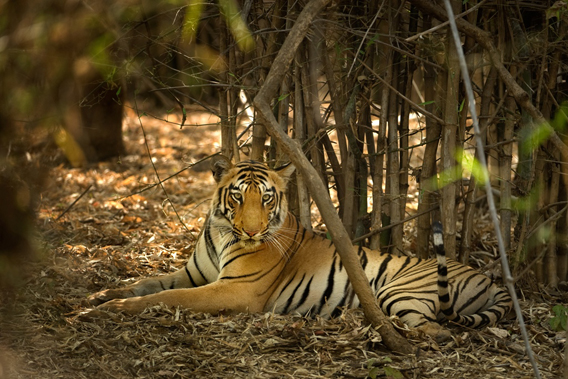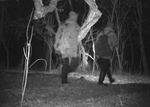
The tiger is a globally endangered top predator occupying only 7% of its historic range and only 3000-3500 individuals are believed to be left in wild. Picture © Kalyan Varma.
Nepal’s Chitwan National Park was the site of a study, published in September 2012 by Carter and others, which concluded that, tigers coexist with humans at fine spatial scales. This paper has ignited a scientific debate regarding its implications for large carnivore conservation worldwide, with scientists at institutions worldwide questioning the validity of claims of coexistence. At the foundation of this debate, perhaps, is the unresolved question, “what is coexistence”? For some, ‘coexistence’ is a situation of mutual well-being, devoid of conflict. Carter and colleagues equate coexistence to humans and tigers using the same spatial locations, albeit at different times of the day. Whether such a definition, bereft of other influences, including dispersal, human-wildlife conflict and human perceptions of tigers is appropriate for the purposes of a conservation paradigm needs to be re-examined.
Tigers have been studied at Chitwan National Park since the 1970s and there is a rich body of knowledge on various aspects of their biology. Eminent carnivore biologist, Professor Melvin E Sunquist, noted that while tigers in Chitwan were mostly active at night, some daytime activity also occurred. The tigers, he concluded were matching their activity patterns with that of their prey. Tigers do not take the ‘night shift’ at Chitwan National Park just to ‘coexist’ with people, they have, in fact, evolved so. There is evidence that tigers are avoiding people in other ways. During the day, Carter and his colleagues found that tigers were four times more active inside the Park, which has fewer people as compared to outside the Park where there are more people. Moreover, the chances of detecting a tiger increased in areas further away from human settlements, perhaps indicating lower tiger activity with an increment in human presence. Moreover, tiger densities in these areas are 65-75% less than the density of 18 tigers per 100 km2 reported by Adam Barlow and colleagues in a different part of Chitwan! Thus avoidance was clearly occurring in space.
A clue to the low tiger densities in these areas lies in the mechanism of tiger dispersal. Sub-adult tigers or transients, leave their natal area and stake their claim to a piece of forest they can call home. Dispersal is a period of high risk in the lives of these territorial animals. Long-term tiger biologist Professor James L. David Smith studied tiger dispersal at Chitwan and found that while almost all female sub-adults established territories next to their mothers, male sub-adults moved away to poorer quality habitats, often coming into conflict with humans. Eventually, out of the ten young male tigers Professor Smith closely studied, only four survived. Such areas where a considerable number of tiger deaths occur are ‘sinks’ for tiger populations. A landscape comprising such ‘sinks’ in addition to regions of high survival for the species, or ‘sources’, forms the basis of the current conservation strategy for the species. Senior scientist at Wildlife Conservation Society, Dr. Ullas Karanth, warns that confusing human-dominated ‘sinks’ with ‘sources’ could sound the death knell for this endangered species.
A crucial obstacle to the consideration of coexistence as a conservation strategy in the Chitwan landscape is the high incidence of human-tiger conflict around the park. A study undertaken by Bhim Bahadur Gurung and colleagues suggests that as many as ninety people have been killed by tigers in the Chitwan landscape in the last three decades, while up to 20 tigers have been killed or captured as a management intervention by park authorities in the same period. The trend indicates that the incidence of conflict is increasing and human casualties attributed to tigers within the last decade at Chitwan were 9 times higher than casualties occurring in Bardia National Park. Bardia, also located in Nepal, is similar in size to Chitwan and has a comparable tiger density of 20 animals per 100 km2, as reported by Per Wegge and others. However, Bardia differs from Chitwan in one aspect; there is minimal overlap between tigers and humans, even in the buffer, reports biologist Babu Ram Bhattarai. The negative consequences of conflict in Chitwan is expressed in the perspectives of humans towards tigers and their conservation; in another study, Carter and colleagues report that 40% of the interviewees living adjacent to Chitwan National Park believe that, “tigers are a nuisance and that there is not enough room for both tigers and people in the nearby forests”.
According to the BBC, increasing human-wildlife conflict in Nepal has resulted in government officials wanting to cap growth of wild animal populations in protected areas, including that of the already endangered tiger. In the face of these developments, mere spatial overlaps between humans and tigers cannot be touted as ‘coexistence’ in Chitwan. Research in multiple-use areas having implications for wildlife conservation and human well-being should reflect the on ground realities of both actors living in close proximity to each other.
CITATIONS: Varun R Goswami, Divya Vasudev, Divya Karnad, Y Chaitanya Krishna, Meghna Krishnadas, Milind Pariwakam, Tarun Nair, Anish Andheria, Sachin Sridhara, and Imran Siddiqui. 2013. Conflict of human-wildlife coexistence. PNAS 110(2): E108.
Abhishek Harihar, Pranav Chanchani, Rishi Kumar Sharma, Joseph Vattakaven, Sanjay Gubbi, Bivash Pandav, and Barry Noon. 2013. Conflating “co-occurrence” with “coexistence”. PNAS 110(2): E109.
K Ullas Karanth, Arjun M Gopalaswamy, Krithi K Karanth, John Goodrich, John Seidensticker, and John G Robinson. 2013. Sinks as saviors: Why flawed inference cannot assist tiger recovery. PNAS 110(2): E110.
Carter, N. H., Shrestha, B. K., Karki, J. B., Pradhan, N. M. B., & Liu, J. 2013. Reply to Goswami et al., Harihar et al., and Karanth et al.: Fine-scale interactions between tigers and people. PNAS 110(2), E111-E112.
Carter, N. H., et al 2012. Coexistence between wildlife and humans at fine spatial scales. 10.1073/pnas.1210490109
PNAS September 18, 2012 vol. 109 no. 38 15360-15365
Chaitanya Krishna is from the Indian Institute of Science, Bangalore and is currently based at Princeton University on a Fulbright-Nehru Doctoral and Professional Research Fellowship.
Related articles
Tigers and humans can coexist, says study
(09/04/2012) Humans and tigers can coexist in the same area with minimal conflict, finds a new study that raises hopes for big cat conservation.
Living beside a tiger reserve: scientists study compensation for human-wildlife conflict in India

(01/21/2013) During an average year, 87% of households surrounding Kanha Tiger Reserve in Central India report experiencing some kind of conflict with wild animals, according to a new paper in the open-access journal PLOS One. Co-existence with protected, free-roaming wildlife can be a challenge when living at the edge of a tiger reserve. “Local residents most often directly bear the costs of living alongside wildlife and may have limited ability to cope with losses” wrote the authors of the new paper.

(01/10/2013) Destruction of rainforests and peatlands on the Indonesian island of Sumatra by the pulp and paper industry is worsening conflict between tigers and humans, including fatal encounters, alleges a new report published by a coalition of environmental groups in Riau, Sumatra. The report looks specifically at five concessions operated by companies that supply wood to Asia Pulp & Paper (APP) and its corporate parent, the Sinar Mas Group (SMG). The report says that the majority of human-tiger conflict incidents in Riau between 1997 and 2009 occurred within these concessions.
Conservationists turn camera traps on tiger poachers

(11/12/2012) Remote camera traps, which take photos or video when a sensor is triggered, have been increasingly used to document rare and shy wildlife, but now conservationists are taking the technology one step further: detecting poachers. Already, camera traps set up for wildlife have captured images of park trespassers and poachers worldwide, but for the first time conservationists are setting camera traps with the specific goal of tracking illegal activity.
Wildlife trade bans may be worsening trafficking of some species, argues paper
(09/18/2012) While founded with good intentions, wildlife trade bans may in some cases be worsening the plight of some endangered species, argues a commentary published in the journal Tropical Conservation Science.
Yuppies are killing rhinos, tigers, elephants
(09/07/2012) Yuppies, not elderly rural consumer, are driving the trade that is decimating some of the world’s most iconic endangered species, including tigers, elephants, rhinos, pangolins, and bears, said experts meeting at a workshop in Vietnam.
Photos: Asia’s disappearing species
(09/05/2012) To highlight the plight of Asia’s biodiversity, which is facing a range of threats from deforestation to the wildlife trade, the Wildlife Conservation Society today released a list of Asian species in need of immediate conservation action.
Tiger and cubs filmed near proposed dam in Thailand
(09/04/2012) A tigress and two cubs have been filmed by remote camera trap in a forest under threat by a $400 million dam in Thailand. To be built on the Mae Wong River, the dam imperils two Thai protected areas, Mae Wong National Park and Huay Kha Khaeng Wildlife Sanctuary, according to the World Wide Fund for Nature (WWF)